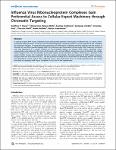Influenza Virus Ribonucleoprotein Complexes Gain Preferential Access to Cellular Export Machinery through Chromatin Targeting
Chase, Geoffrey P.
Rameix-Welti, Marie-Anne
Zvirbliene, Aurelija
Zvirblis, Gintautas
Götz, Veronika
Wolff, Thorsten
Naffakh, Nadia
Schwemmle, Martin
In contrast to most RNA viruses, influenza viruses replicate their genome in the nucleus of infected cells. As a result, newly-synthesized vRNA genomes, in the form of viral ribonucleoprotein complexes (vRNPs), must be exported to the cytoplasm for productive infection. To characterize the composition of vRNP export complexes and their interplay with the nucleus of infected cells, we affinity-purified tagged vRNPs from biochemically fractionated infected nuclei. After treatment of infected cells with leptomycin B, a potent inhibitor of Crm1-mediated export, we isolated vRNP export complexes which, unexpectedly, were tethered to the host-cell chromatin with very high affinity. At late time points of infection, the cellular export receptor Crm1 also accumulated at the same regions of the chromatin as vRNPs, which led to a decrease in the export of other nuclear Crm1 substrates from the nucleus. Interestingly, chromatin targeting of vRNP export complexes brought them into association with Rcc1, the Ran guanine exchange factor responsible for generating RanGTP and driving Crm1-dependent nuclear export. Thus, influenza viruses gain preferential access to newly-generated host cell export machinery by targeting vRNP export complexes at the sites of Ran regeneration.
Dateien zu dieser Publikation
Keine Lizenzangabe
Verwandte Publikationen
Anzeige der Publikationen mit ähnlichem Titel, Autor, Urheber und Thema.
-
2013-03-11ZeitschriftenartikelTowards further reduction and replacement of animal bioassays in prion research by cell and protein misfolding cyclic amplification assays Boerner, Susann; Wagenführ, Katja; Daus, Martin L.; Thomzig, Achim; Beekes, MichaelLaboratory animals have long since been used extensively in bioassays for prions in order to quantify, usually in terms of median infective doses [ID50], how infectious these pathogens are in vivo. The identification of ...
-
2010-07-08ZeitschriftenartikelLegionella pneumophila induces human beta Defensin-3 in pulmonary cells Scharf, Stefanie; Vardarova, Kremena; Lang, Friederike; Schmeck, Bernd; Opitz, Bastian; Flieger, Antje; Heuner, Klaus; Hippenstiel, Stefan; Suttorp, Norbert; N'Guessan, Philippe DBackground: Legionella pneumophila is an important causative agent of severe pneumonia in humans. Human alveolar epithelium and macrophages are effective barriers for inhaled microorganisms and actively participate in the ...
-
2011-06-28ZeitschriftenartikelMolecular in situ topology of Aczonin/Piccolo and associated proteins at the mammalian neurotransmitter release site Limbach, Christoph; Laue, Michael; Wang, Xiaolu; Hu, Bin; Thiede, Nadine; Hultqvist, Greta; Kilimann, Manfred W.The protein machinery of neurotransmitter exocytosis requires efficient orchestration in space and time, for speed and precision of neurotransmission and also for synaptic ontogeny and plasticity. However, its spatial ...

